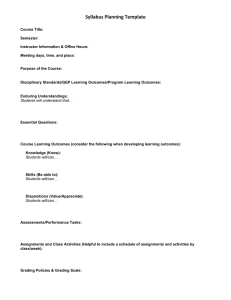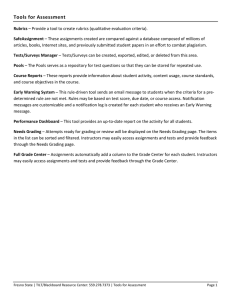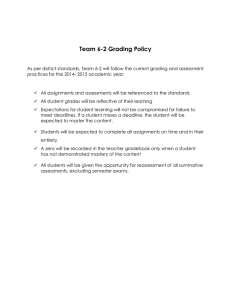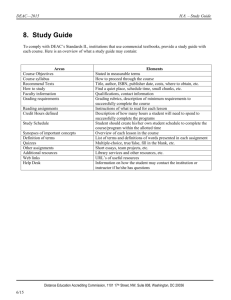Characteristics of Effective Assignments and Evaluation
advertisement
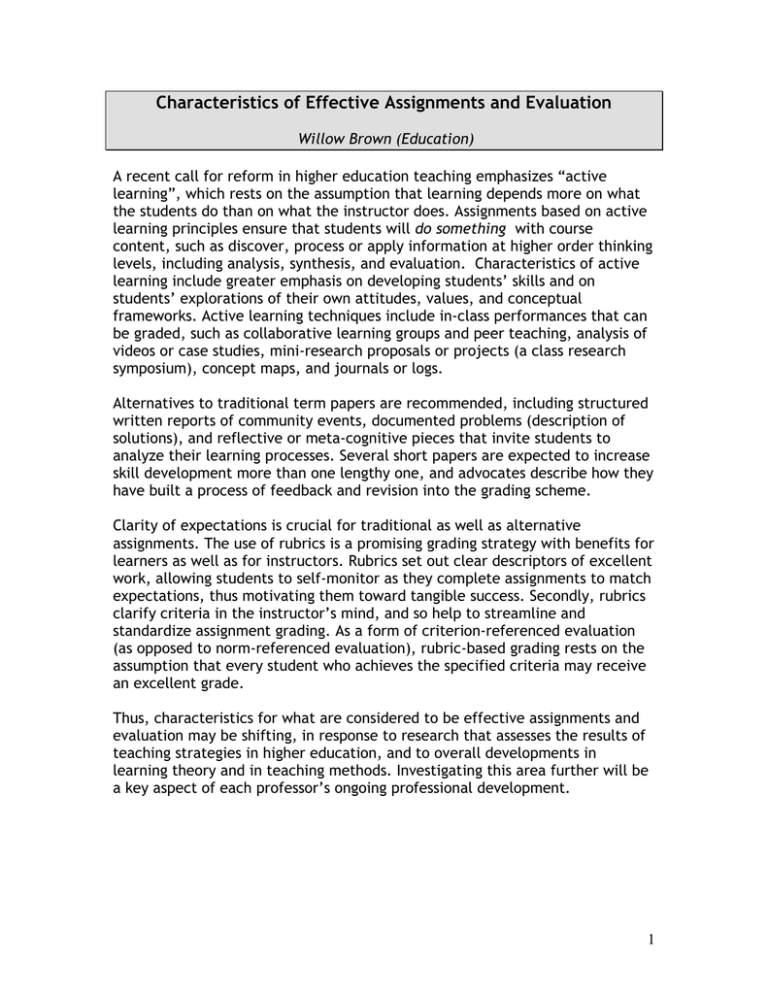
Characteristics of Effective Assignments and Evaluation Willow Brown (Education) A recent call for reform in higher education teaching emphasizes “active learning”, which rests on the assumption that learning depends more on what the students do than on what the instructor does. Assignments based on active learning principles ensure that students will do something with course content, such as discover, process or apply information at higher order thinking levels, including analysis, synthesis, and evaluation. Characteristics of active learning include greater emphasis on developing students’ skills and on students’ explorations of their own attitudes, values, and conceptual frameworks. Active learning techniques include in-class performances that can be graded, such as collaborative learning groups and peer teaching, analysis of videos or case studies, mini-research proposals or projects (a class research symposium), concept maps, and journals or logs. Alternatives to traditional term papers are recommended, including structured written reports of community events, documented problems (description of solutions), and reflective or meta-cognitive pieces that invite students to analyze their learning processes. Several short papers are expected to increase skill development more than one lengthy one, and advocates describe how they have built a process of feedback and revision into the grading scheme. Clarity of expectations is crucial for traditional as well as alternative assignments. The use of rubrics is a promising grading strategy with benefits for learners as well as for instructors. Rubrics set out clear descriptors of excellent work, allowing students to self-monitor as they complete assignments to match expectations, thus motivating them toward tangible success. Secondly, rubrics clarify criteria in the instructor’s mind, and so help to streamline and standardize assignment grading. As a form of criterion-referenced evaluation (as opposed to norm-referenced evaluation), rubric-based grading rests on the assumption that every student who achieves the specified criteria may receive an excellent grade. Thus, characteristics for what are considered to be effective assignments and evaluation may be shifting, in response to research that assesses the results of teaching strategies in higher education, and to overall developments in learning theory and in teaching methods. Investigating this area further will be a key aspect of each professor’s ongoing professional development. 1 Some suggestions • • • • • • • • • • Provide assignments that relate clearly to course objectives and require students to demonstrate their ability to use new information Adhere to the UNBC Undergraduate Grading System (for both assignments and exams) as well as regulations regarding examinations (on pages 109-110 of the Calendar) Clarify expectations re: late assignments, extensions in your course syllabus Explore formative evaluation strategies (check for understanding, provide support for improvement) as well as summative evaluation strategies for grading purposes If a final exam is scheduled, plan a mid-term of similar format so students can become accustomed to your evaluation style Prepare test questions as you plan course delivery, and then make selections from this question bank to reflect what was actually taught Use a variety of question types, e.g. multiple choice, written answers Consider student generated exam questions for review or for actual exams: students will be required to review and process the material actively, and will gain a better understanding of the difficulties in test construction As you grade papers, make notes as to effectiveness of questions and revise subsequent evaluations accordingly Clarify your understanding of the purpose of evaluation, and strive to align evaluative practices with this philosophy, within requirements as set out in university policy References • McKinney, K. Active Learning. Retrieved Aug. 26, 2004 from www.cat.ilstu.edu/teaching_tips/handouts/newactive.shtml (note underscore between “teaching” and “tips” Additional Resources • • • • Journal of Scholarship of Teaching and Learning – Electronic Journal Homepage at http://titans.iusb.edu/josotl/ Journal on Excellence in College Teaching – Electronic Journal Homepage at http://ject.lib.muohio.edu/ Rubistar , a website that facilitates the creation of rubrics for a wide variety of assignments, includes suggested criteria, available online at http://rubistar.4teachers.org/index.php Imagine! [videorecording]: Assessments that energize students, Assessment Training Institute and Canter & Associates. (UNBC Library LB3051.143) 2 • • • Spandel, V. & Stiggins, R. (1990). Creating writers: Linking assessment and writing instruction. New York: Longman. University of Medicine and Dentistry of New Jersey, Center for Teaching Excellence: Student evaluation and assessment. Available online at http://www.umdnj.edu/meg/evaluation.htm (contains links to articles, e.g. constructing tests and writing test items, analyzing tests and test items) Wiggins, G. (1993). Assessing student performance: Exploring the purpose and limits of testing. San Francisco: Jossey-Bass Publishers (UNBC Library LB3051.W494) 3
